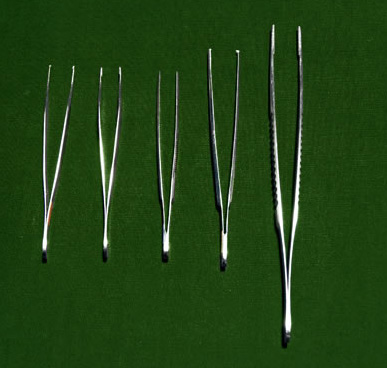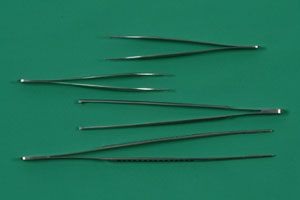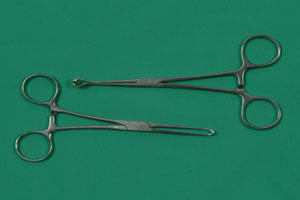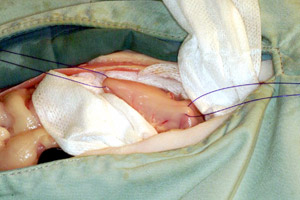Overview
- “tweezer-like” instruments
- used to manipulate tissues and needles
- when used properly
- cause less trauma than fingers
- allow more accurate manipulation of tissues,needles, and suture
Skills to Practice
- pencil grip hold
- atraumatic, efficient manipulation of "tissues"
- efficient extraction of needle tip from tissues during suturing
Basics
Tissue forceps are used to:
- manipulate tissues
- support tissues while making incisions, and suturing
- retract tissues to improve exposure
- grasp suture materials and needles
- “ become your fingers in most cases” as usually less traumatic, more accurate and faster
- a variety of size and designs
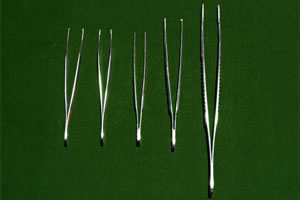
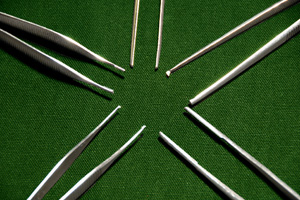
Thumb Forceps
- Small grooves, but no teeth on the tips
- Hold tissue by pressure applied to the handles
- Amount of trauma (crushing) varies with
- amount of pressure
- size and design of tips and grooves
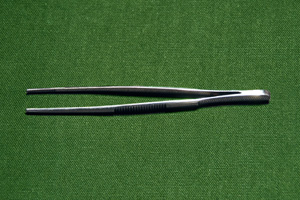
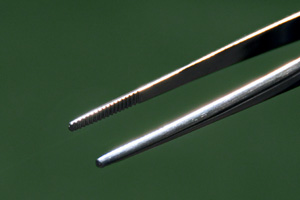
Tissue forceps
- tips have small teeth
- size and number of teeth vary
- teeth penetrate tissue to hold it
- preferred by most surgeons over thumb forceps because:
- less crushing injury
- more secure hold with less finger pressure
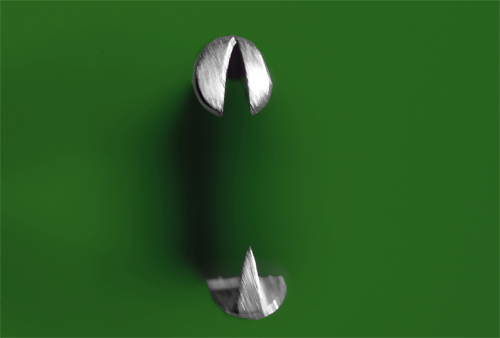
Types of Forceps
Considerations in Forcep Selection
- size and design of tips
- length of handles
- security of hold relative to the pressure exerted
- amount of tissue trauma induced
- tissue being manipulated
- depth of area working in
- surgeon preference
Standard
- also called "rat tooths"
- strong tips
- described by the number of teeth present (eg. 2x1 or 2x3)
- useful to manipulate heavy tissue (eg. fascia)
- Large teeth make them inappropriate for delicate tissues.
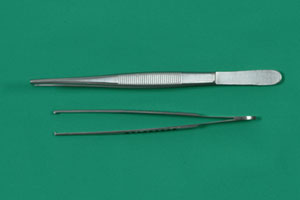
Adson
- fine tips with broad handles
- smaller size more appropriate for small animals
- 2 x 1 (2 teeth on one tip, 1 tooth on other arm)
- provide a secure, delicate grasp with minimal crushing injury
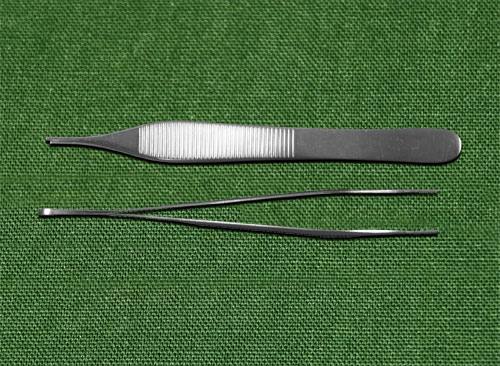

Brown-Adson
- fine tips with broad handles
- multiple columns of fine interlocking teeth
- provide a delicate, but secure, grasp
- also useful for manipulating small needles during suturing

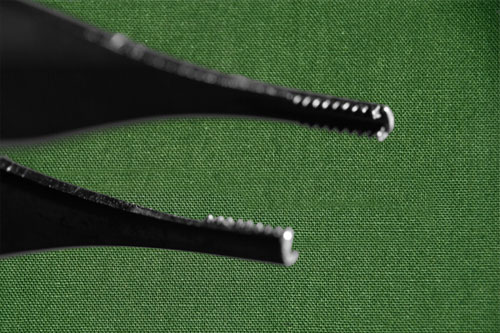
DeBakey thoracic
- series of longitudinal and transverse grooves
- designed to atraumatically manipulate vessels and fragile tissues
- useful for manipulating needles during suturing
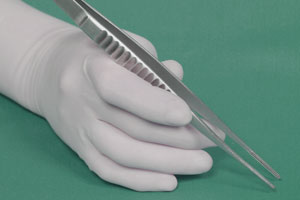
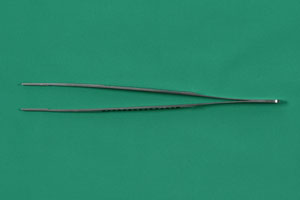
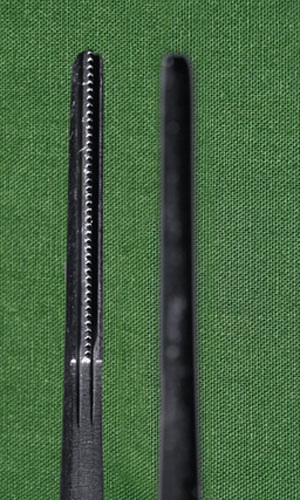
Miscellaneous
A variety of forceps with ringed handles and locking mechanisms are available for manipulating tissues. These are useful for prolonged grasping and tissue manipulation as long as the amount of tissue trauma induced is considered. Less traumatic alternatives include stay sutures, the assistant’s hands or fingers and non-crushing forceps or tissue retractors.
Allis tissue forceps
- provide a secure hold for prolonged periods
- have a series of interlocking teeth along the tips
- ring handles with a ratchet locking mechanism
- grasp tissue by a combination of crushing and teeth interdigitation
- traumatic so restrict use to tissue being excised
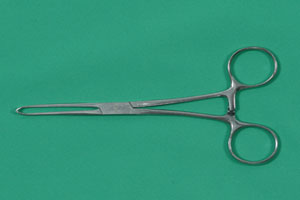 |
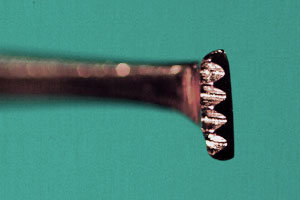 |
Babcock forceps
- similar design
- grasping surface consists of a series of longitudinal grooves
- less traumatic but hold less securely
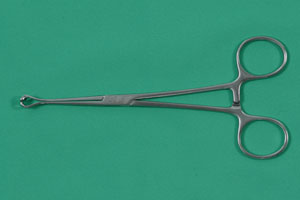 |
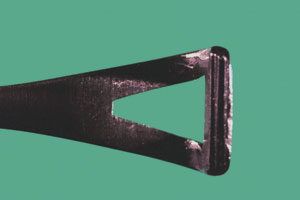 |
Holds
Holding the forceps
- held in the non-dominant hand with a pencil grip
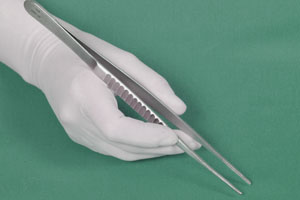 |
|
Pencil Grip
- avoid holding with a palm grip which may at first may feel more natural because:
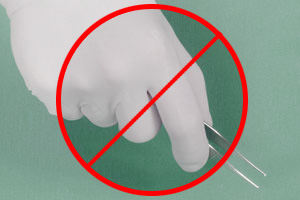
- hampers maneuverability
- less efficient
- grasp applies more pressure causing more crush injury
How to Use
Using tissue or thumb forceps
- grasp the minimal amount of tissue that provides a secure hold with the least amount of pressure
- avoid handling skin when possible (bruises easily)
- handle the subcutaneous tissue instead
To minimize trauma
- limit the number of times tissue is grasped
- minimal pressure of hold
- minimize duration held
- Use stay sutures if need repeated or prolonged manipulation
- When not in use, hold in palm of non-dominant hand
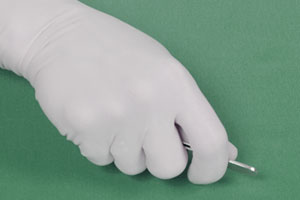
Skills to Master
- correct hold of the tissue forceps (pencil grip, NOT palm grip)
- manipulating "tissues"
- extracting needles from tissue during suturing
Practice: Tissue Forceps
- pick up small round objects (e.g. beads, pepper corns, sesame seeds) and place in container until hold is comfortable and accurate
- pick pulp out of an orange section
- hold forceps in palm of hand while perform instrument knot (during lab 2)
- extract needle from "tissue" during suturing (during lab 3)


